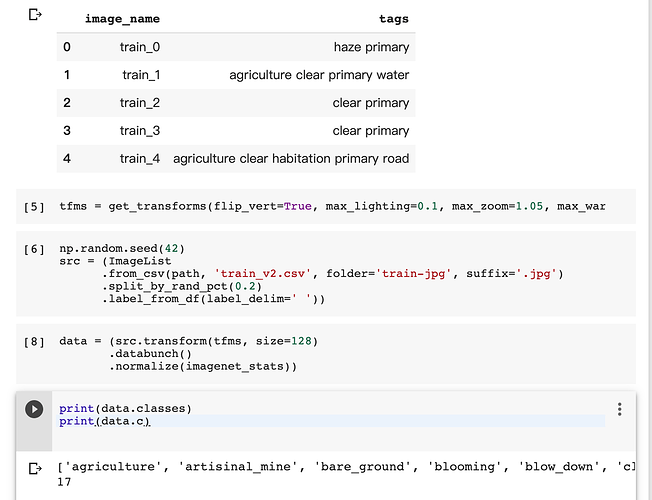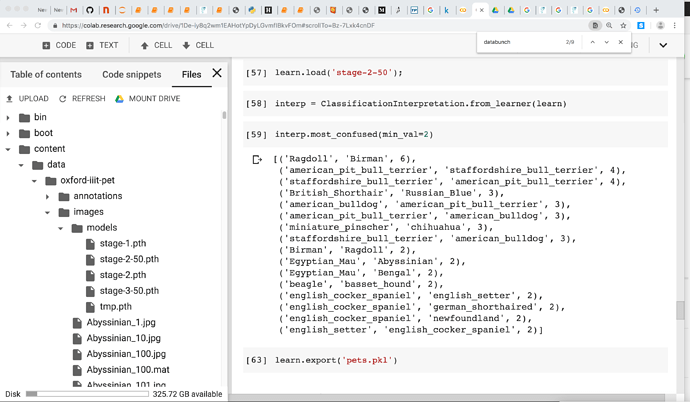I got the same purple images.
I’m not sure what led to the change to plot_top_losses, but there is a field named heatmap that defaults to True. If you change that code block to the following, it will render the images without the purple overlayed
interp.plot_top_losses(9, figsize=(15,11), heatmap=False)
@zrsmithson,
Thx a lot. It worked!!
When I run the below code of lesson3-planet on Colab, I have encountered this problem:
data = (src.transform(tfms, size=128)
.databunch()
.normalize(imagenet_stats))
however,sometimes it worked well with the same code,I feel really confused.  Anyone can help me?
Anyone can help me?
Regarding 00_notebook_tutorial, cat_example.jpg is not found, I didn’t need to modify the path. However, I did need to follow instructions in “Getting Set Up”. (I’m also using Colab.) In particular, in Step 4, there is a note that indicates that four lines of code need to be inserted at the top of every jupyter notebook. Once I inserted the lines (and executed them), the cat image appeared. Hope this helps someone.
does anyone know why the runtime keeps getting interrupted after I use ImageCleaner() ??
Just putting this here as I just noticed, if you look at the Files tab, we can select MOUNT DRIVE and it will automatically put the code to mount your Google Drive into a cell!
Right click on the folder and copy the path to the folder. It might work then.
Thank for @pooya_drv to slightly modify the fastai repo and make this repo tailored for Colab. So, Perth Machine Learning Group could successfully run the Women in Machine Learning Workshop yesterday.
Note: Added the Colab repo link in Wiki.
I downloaded the .pth file of my trained model, however when I returned to training the model (I am working on colab and uploaded the file to /content/models and had created the learner before ),I tried loading the state to the learner using-
learn.load(‘stage_x’)
I was given the error–
unexpected EOF. The file might be corrupted.
Could you help me with this?
Hello! can somebody tell me where the .pkl file is stored as I can’t find it on colab.
Above is my session all the .pth files are there but no “pets.pkl”
Many Thanks mrfabulous1 


Excited to announce my new widget you guys can use!
I’m working on porting over ImageCleaner so it’s useable for us, but this was my first step in learning about how widgets work in Colab
Hi, i am sharan from india. Has anyone done image scrapping on colab? if so can u share github link. i am facing error while trying to download images.
Solved learn.export() now requires a path and a name.
mrfabulous1 

# this is where you store you data
PATH=Config().data_path()/Path('rossmann/')
# first you need to download .tgz file from url (rossmann.tgz isn't in fast.ai URLs)
!wget -P {PATH} http://files.fast.ai/part2/lesson14/rossmann.tgz
# then you should unzip the file and get all the .csv files
!tar -xzf ./data/rossmann/rossmann.tgz -C ./data/rossmann/A quick little note I noticed. Along with the new ‘beta-testing’ feature that they’re implementing, when I ran into a memory error due to a large pandas dataframe, I got prompted to start a “Large Memory Instance”. This new instance has 25gb of RAM available!
Hi muellerzr I am just doing lesson 3 at the moment so am still learning, however I’ve built 12 different simple classifiers apps.
I wouldn’t worry because if your test set is composed of data that model recognizes easily, then isn’t it likely that the test set could achieve higher accuracy than the calculated accuracy of the model?
My hypothesis is that If I had 2 pieces of data that I passed to a model and one passed and one failed.
If I then created 2 test sets one based on the pass data the other on the fail data.
I would expect 100% accuracy in one set and 100% failure in the other set irrespective of the accuracy of the model.
My reason for this hypothesis is that I recently created a model based on the MINST data set which is black and white. It had a 94% accuracy. I then passed it a test set of colored images and it’s performance was terrible.
I then created a classifier using colored images and passed it the MINST data set the performance was. excellent.
When I a have a made a few tabular apps I will be able test some more.
Cheers mrfabulous1 

@mrfabulous1 that sounds to me like you’re purposefully trying to play to the test set, which isn’t what we want  The test set in question was a random subsample of 10% of my data, to which I realized was the wrong way to do it for such a tabular problem. I instead needed to do like jeremy does in lesson 7 with Rossmann and time-series like data. Thanks though!!!
The test set in question was a random subsample of 10% of my data, to which I realized was the wrong way to do it for such a tabular problem. I instead needed to do like jeremy does in lesson 7 with Rossmann and time-series like data. Thanks though!!! 
Hi muellerzr thanks for your comments, they will put me in a good position for when I get to lesson 7.
Cheers mrfabulous1 





